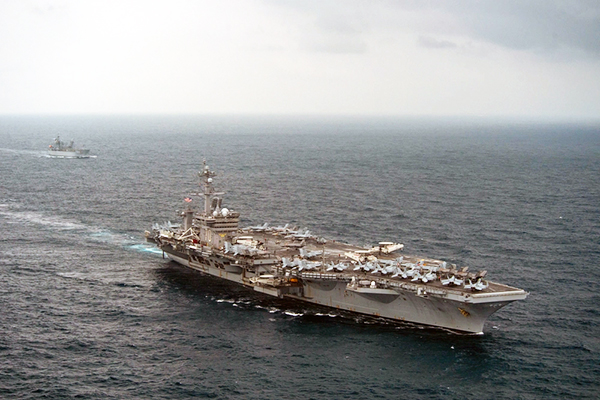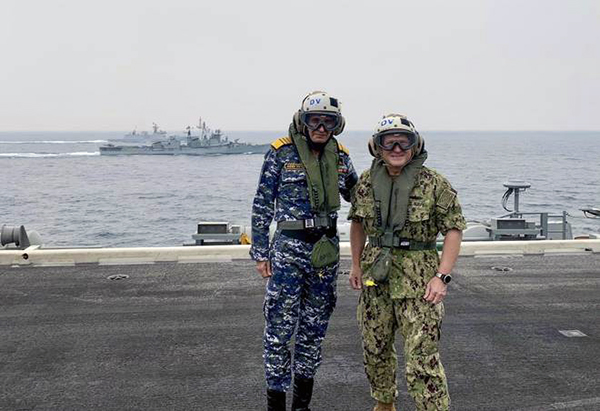
Phase 2 Held in Bay of Bengal
The Indian Navy (IN) participated in the Second Phase of Multilateral Maritime Exercise Malabar along with the Japan Maritime Self Defence Force (JMSDF), Royal Australian Navy (RAN) and the United States Navy (USN). The exercise was conducted in the Bay of Bengal from 12 – 15 Oct 2021. First Phase of the exercise was conducted in the Philippines Sea from 26 – 29 Aug 2021.
The Indian Navy’s participation included INS Ranvijay, INS Satpura, P8I Long Range Maritime Patrol Aircraft and a Submarine. The US Navy was represented by the Aircraft Carrier USS Carl Vinson along with two destroyers, USS Lake Champlain and USS Stockdale. The JMSDF was represented by JS Kaga and JS Murasame. The Royal Australian Navy was represented by HMAS Ballarat and HMAS Sirius.
The Second Phase of the exercise built upon the synergy, coordination and inter-operability developed during the First Phase of the exercise and focussed on advanced surface and anti-submarine warfare exercises, seamanship evolutions and weapon firings.
The Malabar series of exercises, which began as an annual bilateral naval exercise between India and the US in 1992, has seen increasing scope and complexity over the years. The 25th edition of Malabar, conducted in two phases, while observing all protocols during the COVID-19 pandemic, was reflective of the commitment of the participating countries to support a free, open, inclusive Indo-Pacific as well as a rules-based international order.
On the role of Malabar-2021, Chief of Naval Operations (CNO), U.S. Navy, Michael Gilday, said that about 60% of global maritime trade passes through the IOR region, which includes 90% of the oil. The economy of any country depends on free and secure maritime trade and our vision is to hold such joint exercises to keep the oceans free and secure, he said.
The exercise not only opens up naval cooperation among the four countries but also makes trade in the region easier. It is one of the duties of the navy to provide free passage to the commercial trade and such exercises bolster the cause.
First Phase
The Quad countries — Australia, Japan, India, and the United States — participated in the first phase of Malabar naval exercises off the coast of Guam from August 26-29. This was the second time in a row that the exercise included Australia. Since 2015, Japan has been a permanent partner in the exercise.

In a press release, the Indian Ministry of Defence said that “Malabar-21 would witness high-tempo exercises conducted between destroyers, frigates, corvettes, submarines, helicopters and Long Range Maritime Patrol Aircraft of the participating navies. Complex surface, sub-surface and air operations including Live Weapon Firing Drills, Anti-Surface, Anti-Air and Anti-Submarine Warfare Drills, Joint Manoeuvres and Tactical exercises will be conducted during the exercise.”
Indian frigate INS Shivalik and corvette INS Kadmatt took part in the first phase. The two ships were already in the region as part of their scheduled deployment to Southeast Asia from August 9 onward. Prior to their arrival in Guam for the Malabar 21 exercise, the two ships were in Brunei for an annual exercise and professional interactions with the Royal Brunei Navy.
China’s Concern
China has looked at the growing Quad engagements, and the Malabar exercises in particular, with increasing concern. China has also stepped up its naval exercises. It carried out a live ammunition training near Guangdong in the South China Sea and off the northeast coast near Liaoning in the Yellow Sea and Bohai Strait. The exercises appeared to be conducted with the goal of sending a message of force and strength to the U.S. and its Indo-Pacific partners.
The fact that Australia has become a “regular” partner in the Malabar series of exercises is an indication of India’s hardening position as it pertains to China.
In April 2021, the Quad plus France engaged in the La Pérouse exercise in the Bay of Bengal, reflecting the growing strategic convergence among a number of Quad-plus countries in ensuring a free and open Indo-Pacific that is respectful of a rules-based order.
China has been suspicious about the purpose of the Malabar exercise as it feels that the annual war game is an effort to contain its influence in the Indo-Pacific region.

















